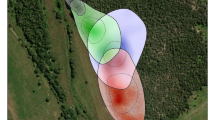Summary
In this paper I consider how the costs and benefits of group living in spider monkeys (Ateles geoffroyi) vary between troop members. The results suggest that ecological factors set an upper limit to the number of spider monkeys that can associate and still efficiently exploit the available resources. In addition, the needs of the individual appears to influence the type and size of the subgroup it chooses. Adult males band together, travel over a large area, and are frequently sighted near the community's boundary. In contrast, adult females spend more time solitary than males and have association patterns that are strongly influenced by the presence of a dependent infant. Females with dependent infants tend to travel in small subgroups or alone, avoid the boundaries of the community's home range, and exhibit a restricted pattern of use of their range. The results suggest that males may be attempting to locate females with which they can breed, while mothers attempt to protect their infants by avoiding conspecifics and potentially dangerous situations near territorial boundaries.
Similar content being viewed by others
References
Bradbury JW, Vehrencamp S (1976) Social organization and foraging in emballonurid bats. II. A model for the determination of group size. Behav Ecol Sociobiol 1:383–404
Chapman CA (1988 a) Patterns of foraging and range use by three species of neotropical primates. Primates 29:177–194
Chapman CA (1988 b) Patch use and patch depletion by the spider and howling monkeys of Santa Rosa National Park, Costa Rica. Behaviour 150:99–116
Chapman CA, Chapman LJ (1990) Density and growth rate of some tropical dry forest trees: comparisons between successional forest types. Bull Torrey Bot Club (in press)
Chapman CA, Fedigan LM, Fedigan L, Chapman LJ (1989) Post-weaning resource competition and sex ratios in spider monkeys. Oikos 54:315–319
Clark CW, Mangel M (1986) The evolutionary advantages of group foraging. Theor Popul Biol 30:45–75
Conover WJ (1980) Practical nonparametric statitics. Wiley, New York
Glander KE, Fedigan LM, Fedigan L, Chapman C (1990) Capture techniques for three species of monkeys in Costa Rica (in press)
Janson C (1985) Aggressive competition and individual food consumption in wild brown capuchin monkeys (Cebus apella). Behav Ecol Sociobiol 18:125–138
Janzen DH (1986) Guanacaste National Park. (Editorial). University of Estratal a Distancia, San Jose, Costa Rica
Jarman PJ (1974) The social oranization of antelope in relation to their ecology. Behaviour 48:215–267
Jarman PJ (1983) Mating systems and sexual dimorphism in large, terrestrial, mammalian herbivores. Biol Rev 58:485–520
Klein LL (1972) The ecology and social organization of the spider monkey Ateles helzebuth. Ph D Dissertation. University of California, Berkeley
Klein LL, Klein DB (1977) Feeding behaviour of the Columbian spider monkey. In: Clutton-Brock TH (ed) Primate ecology. Academic Press, London, pp 153–181
Lott D (1984) Intraspecific variation in the social systems of wild vertebrates. Behaviour 88:266–325
Nishida T, Hiraiwa-Hasegawa M (1987) Chimpanzees and Bonobos: Cooperative relationships among males. In: Smuts BB, Cheney DL, Seyfarth RM, Wrangham RW, Struhsaker TT (eds) Primate societies. University of Chicago Press, Chicago, pp 117–165
Peters RH, Cloutier S, Dube D, Evans A, Hastings P, Kaiser H, Kohn D, Sarwer-Foner B (1988) The ecology of the weight of fruit on trees and shrubs in Barbados. Oecologia 74:612–616
Pulliam HR, Caraco T (1984) Living in groups: is there an optimal group size? In: Krebs JR, Davis N (eds) Behavioural ecology. Sunderland, Sinauer, pp 122–147
Schaik CP van (1983) Why are diurnal primates living in groups? Behaviour 87:120–144
Sokal R, Rohlf F (1981) Biometry. Freeman, San Francisco
Symington M (1987) Ecological and social correlates of party size in the black spider monkeys, Ateles paniscus chamek. Ph D Disseration, Princeton University, Princeton
Symington M (1988 a) Demography, ranging patterns, and activity budgets of black spider monkeys (Ateles paniscus chamek) in Mann national Park, Peru. Am J Primatol 15:45–67
Symington M (1988 b) Food competition and foraging party size in the black spider monkey (Ateles paniscus chamek). Behaviour 105:117–134
Whitten PL (1983) Diet and dominance among female vervet monkeys (Cercopithecus aethiops). Am J Primatol 5:139–159
Wrangham RW (1986 a) Evolution of social structure. In: Smuts BB, Cheney DL, Seyfarth RM, Wrangham RW, Struhsaker TT (eds) Primate societies. University of Chicago Press, Chicago, pp 282–296
Wrangham RW (1986 b) Ecology and social relationships in two species of chimpanzees. In: Rubenstein DI, Wrangham RW (eds) Ecological aspects of social evolution. Princeton University Press, Princeton, pp 352–378
Wrangham RW, Rubenstein DI (1986) Social evolution in birds and mammals. In: Rubenstein DI, Wranham RW (eds) Ecological aspects of social evolution. Princeton University Press, Princeton, pp 452–470
Author information
Authors and Affiliations
Rights and permissions
About this article
Cite this article
Chapman, C.A. Association patterns of spider monkeys: the influence of ecology and sex on social organization. Behav Ecol Sociobiol 26, 409–414 (1990). https://doi.org/10.1007/BF00170898
Received:
Accepted:
Issue Date:
DOI: https://doi.org/10.1007/BF00170898




